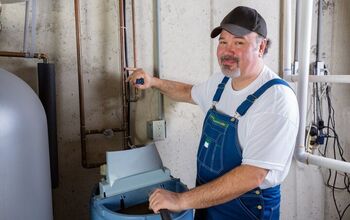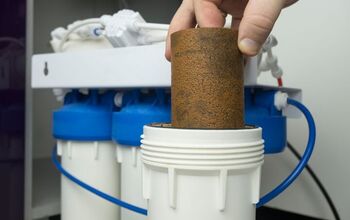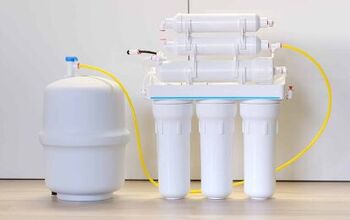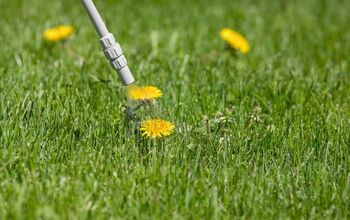How Much Does a Water Softener System Cost?

The need to install a water softener system is standard with homeowners who use well water or anyone who has an issue with metal buildup. The softening system is designed to remove the metal cations such as calcium and magnesium. Although, how much does a water softener cost to install?
The average water softener system costs $1,200. You can expect to spend an average of $350 in labor costs to install a water softener. It can cost an extra $140 if you have to remove and dispose of an old water softener system, and professionals charge $50 in equipment fees.
In this cost guide, we take you through the range of options you can consider. That way, you can understand more about how much money you will need to set aside. This way, you’ll know what to expect and be able to prevent surprise fees or costs.
Need a Water Treatment and Purification System Installed or Replaced?
Get free, zero-commitment quotes from pro contractors near you.

Home Water Softener System Cost
A home water softener system can range from as little as $350 to as high as $2,000, depending on your system choice.
Cost Of Water Softener System | |||
Low | Typical | Average | High |
$350 | $750 – $1,500 | $1,200 | $2,000 |
Several factors influence the price of the system you choose, including:
- Type
- Size
- Additional Features
- Brand
Not all water softeners and conditioners are equal in quality. Those which cost less may have a shorter useful life, need more maintenance and have expensive repairs.
Type
Softeners can be salt-based or salt-free (aka “water conditioners”). Salt-based softeners are typically more expensive. Although, if you are on a sodium-restricted diet, you need to be careful with salt-based softeners. If you drink the water, it will raise your sodium levels, which could be an issue.
Size
The level of your daily water consumption and your water’s hardness should dictate the size of your system. The rate of your water flow is also a factor. You need to use your dishwasher, shower, and faucets simultaneously without any loss of pressure. Ensuring you have the right size will bypass any of these potential issues.
Features
Some of the additional features you’re able to choose from include:
- Digital control heads which allow for simple configuration and are easy monitoring.
- Metered systems that regenerate based on water usage, rather than using a timer. With time-based regeneration, the same amount of water and salt used is always the same. The lower purchase price of time-based systems should be balanced against higher long-term operating costs.
- Environmentally friendly systems– With traditional salt softeners, look for models that minimize water and salt use, which is better for the environment.
Brand
There is no need to pay a premium for fancy features and services which are not required. It is better to go for brands that have proved reliable and serviceable over time, such as Fleck by Pentair.
Water Softener Prices By Type
Price By Type | |
Softener Type | Price Range |
Tank Only (Resin or Brine) | Less than $100 |
Portable Unit | $150 – $300 |
Salt-Free Conditioner | $300 – $700 |
Standard Ion Exchanger | $350 – $1,000 |
Commercial System | $1,500 + |
Dual Tank Ion Exchanger | $1,000 + |
Magnetic Descaler | $100 |
Ion Exchange Water Softener Prices
Typically, expect to pay between $350 and $1,000 a standard ion exchanger. However, a dual-tank system will provide soft water continuously will cost $1,000+.
A 20,000 to 30,000-grain unit from one of the big retailers will cost anything from $350 to $1,000. Capacity is adequate for small or medium-sized properties, but some parts may be of low quality and susceptible to leaks or other problems.
If you have $1,000 to spend, invest in a top-quality 80,000-grain system. This will provide an adequate supply of soft water regardless of the size of your family or home.
Water Conditioner Cost
Unit Prices | |
Unit | Price |
Portable | $150 – $300 |
Commercial | $1,500 – $30,000 |
Tank | $100 or less |
A salt-free water conditioner will cost in the range of $300 to $700. For approximately $100, more compact magnetic or electronic devices are now coming onto the market. There are quite different opinions about descaling, so do some careful research before you buy it. Most products have very disparate customer reviews.
Portable Units
Expect to pay around $150 to $300 for a portable unit. If you purchase one within the higher range, it typically comes with more features.
Commercial Softeners
These are designed to handle hundreds of gallons of water per minute, so they are bigger and more powerful.
Costs start at $1,500 and have been known to go as high as $30,000.
Tank Prices
For less than $100, you can buy either a salt or a resin tank. The costliest component is the control valve, which is essential for all salt-based water softeners.
How Much Does A Water Softener System Cost To Install?
A water treatment system for an entire house needs to be plumbed in. Water softeners also require plumbing. Magnetic descalers are the exception and need no plumbing.
Factors Explanation And Price | ||
Factor | Explanation | Price |
Appliance Removal | Option to pay for the legal disposal of old appliances | $25 – $75 |
Debris Disposal | Disposing of waste and debris from the project | $70 |
Supplies | Cost of materials including connectors and valves | $350 – $2,000 |
Basic Labor | Site preparation, installation, clean up | $50 – $100 |
Equipment | Costs of equipment needed for the job | $50 |
Appliance Removal
To dispose of appliances properly, you will pay around $25 to $75 per appliance. The cost will depend on the size and type of device you are seeking to get rid of. For instance, disposing of a tank may cost more than the other types of units.
Debris Disposal
If you’re replacing an existing system, you’ll likely need to pay an additional $70 to remove debris. However, this price will vary depending on the contractor or company. Or, if you’re doing this yourself, look into dumpster rentals for companies who will dispose of this type of waste.
Supplies
Before you do anything, you will need supplies. These supplies will run between $350 and $2,000, depending on the softening unit you want to install. Most kits include all the necessary components. However, check the package to make sure.
Basic Labor
It is a requirement of individual suppliers, such as Aquasana, that for their warranty to be valid, a licensed plumber must do the installation. This will involve labor costs, supplies, tools and equipment, site preparation, disposal of packaging, materials, and cleanup. Expect this to add from $200 to $500 to the initial cost.
You can also look into buying a package that combines your water softener and the installation service to reduce costs. It may also be possible to get delivery, set-up, and programming, free-of-charge.
Equipment
Basic installation kits can be purchased for $50-$100, so you make real savings. Plumbing tools will be needed, so if you don’t own any, borrow or buy them.
How Much Does A Water Softener Cost Per Month?
Once you’ve found the water system which suits your needs and is within your budget, it’s time to consider the cost of running it every month.
Cost Factors And Price For Mid-Sized Home | |
*Prices based on DIY basic Ion Exchange Softener | |
Cost Factor | Price For First Year |
Salt (12 mo) | $96 |
$150 | |
Installation Kit | $70 |
System Purchase | $500 |
Maintenance | FREE |
Total cost | $816 |
The above pricing guide reflects the average cost to install and run a basic Ion Exchange water softener for a mid-size house. This is about how much you would pay for your first year if you were to install this type of softener yourself.
Cost Factors And Price For Large 3-Bedroom House | |
*Prices based on professional installation of Water Conditioner | |
Cost Factor | Price For First Year |
Chelation Agent (12 mo) | $180 |
$0 | |
Installation | $300 |
System Purchase | $700 |
Maintenance | FREE |
Total cost | $1,180 |
The second chart reflects the use of a large three-bedroom house that uses a water conditioner. Also, the prices reflected in this chart show the averages of professional installation in this circumstance.
Salt
As a very rough estimate, a typical monthly salt requirement is around 40-pounds. A bag can cost anything from $6 to $25, depending on the brand and the purity. For example, at Home Depot, a 40-pound bag of salt pellets by Morton will cost $6.56.
Salt, aka sodium chloride or potassium chloride, is the main cost for an ion exchange water softener. It is required to regenerate the beads in the resin tank, as, over time, they become saturated with hard water ions.
The brine tank, which is often separate from the main softening tank, is where this process takes place. The frequency of refills and the amount of salt you use depends on the hardness of your water. It also depends on your household’s water consumption.
Water And Sewer
Wastewater is produced during the regeneration cycle of salt-based softeners. Depending on your model, this can vary from 20 to 50 gallons per cycle, which will increase your water and sewer bills.
While it’s difficult to give a realistic estimate due to the many factors that can play a part, it is probably reasonable to think of a budget range of $150 to $200 per year. On the other hand, if you have soft water, your overall consumption will probably be lower than if you use unsoftened water. Although, that fact can’t be guaranteed.
Maintenance
A good quality water softener that meets recognized standards should rarely need servicing, if at all. Manufacturers suggest a professional inspection every 12-24 months to ensure it is functioning correctly. Still, if you can configure the control head, it’s probably unnecessary to do it so often.
Every five years or so, with regular use, the brine and resin tanks should be cleaned. This is quite a straightforward task. You may find it more convenient to use a company that provides a salt and maintenance service for your system. Payment is usually monthly, and the cost of this service will be in the region of $120 to $150 per year.
Other Factors To Take Into Consideration
- Resin Tank
The more extensive your tank, the greater the quantity of salt needed to regenerate fully. Interestingly, a partial regeneration is actually more salt efficient. This will require a big enough tank.
- Individual Settings
If you carry out repeated regeneration cycles, you’ll use less salt but use more water, which will be reflected in your water bills.
- Outmoded Systems
An outmoded system will probably use more salt if regeneration is based on a timer, rather than water consumption.
- Other Water Conditions
In cases of elevated TDS or iron content, salt consumption may be elevated.
What Else To Consider
You may require some additional treatments before or after installation. This depends on the quality of your existing water. For example, you may need an under-sink filter. Softening can make the water unsuitable to drink for certain individuals.
However, you could add a reverse osmosis drinking system after installing your water softener. This is a very DIY friendly project, and it will filter the additional salt out of your water.
Where To Buy A Water Softening Unit
The most economical way to purchase a water softener by using an online supplier, such as Amazon. They have a wide choice of systems at every price point. Although, you will be able to find a water softener any of the other following ways:
- Home Depot
- Lowes
- Local Home Improvement Chains
- Your preferred brand’s website
Some people prefer to use local suppliers. Get a few cost estimates so you can use them to bargain with. It’s worth knowing that their low season is towards the end of the year so that prices will be reduced at this time. The end of the year is typically when you can find a lot of bargains and clearance sales.
Can I Install A Water Softener Myself?
Installing water softening units as a DIY project means you can work to your schedule and save money on hiring professionals. Whether it’s a good idea depends on your skill and experience with plumbing.
Water softening units typically require around half a day to complete. The maximum amount of time it will take is about a whole day if you like to take your time and double-check that every step is done correctly. Replacement of existing water softening units typically requires an hour.
Pros Of DIY Installation
- You can take your time and work on the project in line with your schedule
- You’ll avoid installation costs. Dealers, home improvement specialists, plumbers could charge, on average, from $200 to $500.
Cons Of DIY Installation
- You do need an adequate level of plumbing skills, especially for a new installation, or if the property doesn’t already have the plumbing infrastructure required.
- Pipes may require cutting to connect the water softener and your water supply.
- There’s a risk of forgetting simple steps, such as closing the water supply before you start.
Hiring A Professional
If you are not 100% confident about your skill as a plumber, opt for installation by a professional. Of course, it will be more expensive, but you will have peace of mind. Choose someone you’ve previously used, or get references.
Good plumbers tend to be heavily booked, so make your appointment as soon as possible after you buy your water softening unit. Again, someone you’ve worked with previously will make every effort to fit you into his or her schedule.
Make sure the water softening unit has already been delivered and can be checked in advance of the agreed installation date. This way you will know when you need to be home to meet the plumber for installation in case there are personal items that need to be moved.
Need a Water Treatment and Purification System Installed or Replaced?
Get free, zero-commitment quotes from pro contractors near you.

Related Questions
Is a water softener worth it?
While they are quite a significant investment, they do offer substantial benefits. A water softening unit optimizes the efficiency of all your water and heating systems. For example, a scale buildup of as little as 1.6mm could result in as much as a 12% loss in heating efficiency. So, over the long term, you can reduce other costs.
How long do water softeners last?
Expect your water softener to last from 10 to 20 years, according to the sort and brand you choose to purchase. Typically, a single-tank electric water softener has a useful life of around 12 years. On the other hand, a Kinetico system can be expected to last for up to 20 years.
What would happen if I don’t put salt in my water softener?
Your system needs salt to make a brine solution and regenerate its water softening capability. Without an adequate supply, the efficiency of the system will decrease. When the salt has completely disappeared, the system will try to regenerate the media with plain water. Make sure your system has an adequate supply at all times.
How much does it cost to put in a well?
Although you will save money in the long run, well water installation costs can be high. To drill a well of 150 feet, expect to pay around $5,500. Most new wells cost from $1,500 to $12,000.Calculate around $15 and $30 per foot drilled. This can increase to $50 for more complicated terrain. For a shallow well, it may be possible to dig. You’re likely to be charged $10 to $25 per square foot.
What are the disadvantages of a water softener?
A water softener removes different minerals from the water. A lot of these minerals are needed by our bodies to function correctly. In addition, the water softening unit usually leaves the sodium behind.If you are on a sodium-restricted diet, it’s not recommended for you to drink softened water. However, you could always install a water filtration system to combat this issue.

Heather is a passionate writer who loves anything DIY. Growing up, she learned everything from home repairs to design, and wants to share her tips with you. When she's not writing, she's usually hiking or searching for her next DIY project.
More by Heather Robbins



























